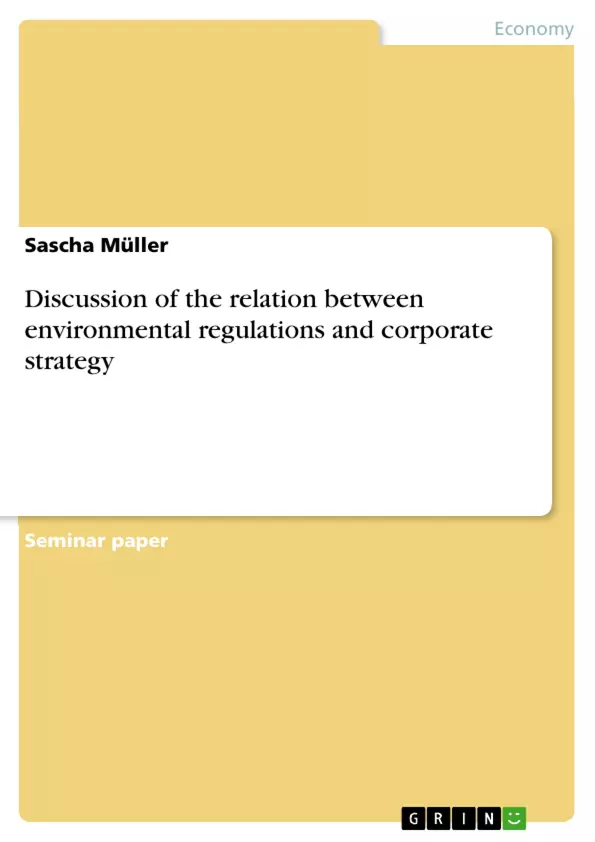Changes in the business environment affect strategic decisions sustainably. The problem firms are facing is that due to the ongoing globalization and cross-linking of companies around the globe, strategic decisions are influenced by both our own environmental changes and those happening to business partners. Hence, decision making has become more complex over the last few decades. The business environment is affected by several factors. Ward et. al. (1995) identified four different variables: business costs, labor availability, market hostility and dynamism.
In this paper the focus is on changing environmental regulations and their effects on corporate strategies. As Larsson et. al. (1996) showed legislative changes have a major effect on strategic decisions and can be decided before long. This makes legislative changes a general concern for change management. Moreover, environmental standards differ from country to country or at least from region to region. Environmental regulations have to be kept in mind if investment decisions are to be made.
In this paper it will be discussed how environmental regulations affect company’s strategies on the basis of Rugman’s and Verbeke’s framework. Before introducing this framework two frequently discussed effects in economic research will also be looked at to point out what variables influence companies’ decisions concerning their strategic environmental decisions.
Inhaltsverzeichnis (Table of Contents)
- Introduction
- Environmental Regulations and their impact on industries
- Pollution haven effect
- Regulatory Chill
- Strategic questions arising
- Environmental regulations and its effect on firm strategy
Zielsetzung und Themenschwerpunkte (Objectives and Key Themes)
This paper investigates the relationship between environmental regulations and corporate strategy. It examines how changing environmental regulations influence companies' strategic decisions, particularly focusing on the impacts of pollution haven effects and regulatory chill. Key themes explored in the paper include:- The influence of environmental regulations on corporate strategy
- The pollution haven effect and its implications for businesses
- The concept of regulatory chill and its impact on developing countries
- The strategic questions arising from these environmental effects
- The framework of Rugman and Verbeke in explaining companies' strategic responses to changing regulations
Zusammenfassung der Kapitel (Chapter Summaries)
Introduction
This chapter provides an overview of the research context and highlights the significance of environmental regulations in influencing corporate strategy. It introduces the key variables affecting the business environment and emphasizes the complexity of decision-making in the context of globalization.Environmental Regulations and their impact on industries
This chapter delves into the effects of environmental regulations on industries, specifically examining the pollution haven effect and regulatory chill.Pollution haven effect
The chapter explores the phenomenon of polluting industries relocating to developing countries with weaker environmental regulations. It examines the empirical evidence supporting the existence of this effect and emphasizes the importance of factors such as regulatory differentials and corporate strategy in influencing industry location decisions.Regulatory Chill
This section focuses on the concept of regulatory chill, where companies lobby against stricter environmental standards. It highlights the clash of interests between proponents of environmental sustainability and those seeking lower production costs. The chapter also examines the role of foreign direct investments (FDI) and the shifting bargaining power between governments and multinational corporations.Strategic questions arising
This section discusses the strategic questions that arise from both the pollution haven effect and regulatory chill. It explores the challenges facing legislators and companies in adapting their strategies to these effects and emphasizes the importance of considering environmental regulations in corporate decision-making.Environmental regulations and its effect on firm strategy
This chapter introduces the framework of Rugman and Verbeke, which supplements Porter's "five forces" analysis with a sixth force: government regulation. The chapter explains how changes in environmental regulations can be viewed as either outcomes or externally determined constraints, leading to potential shifts in corporate strategy.Schlüsselwörter (Keywords)
The paper focuses on environmental regulations, corporate strategy, pollution haven effect, regulatory chill, Rugman and Verbeke framework, FDI, and strategic decision-making in the context of globalization. These keywords represent the primary themes and concepts explored within the paper.- Quote paper
- Sascha Müller (Author), 2011, Discussion of the relation between environmental regulations and corporate strategy, Munich, GRIN Verlag, https://www.grin.com/document/184328



